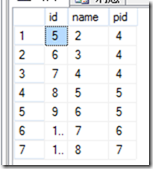用户自定义函数 和存储过程是类似的,
是一组 有序的t-sql语句,udf被 预先优化和编译,并且可以作为一个单元来进行调用.
使用存储过程 时 可传入参数,传出参数.可以返回值,不过该值用于指示成功或者失败,而非返回数据.也可以返回结果集,
但是在没有将结果集插入到某种表(通常是临时表)中以供后面使用的情况下,不能在 查询中真正使用它们. 即使使用
表值 输出参数,在查询中使用结果之前,也要额外的一个步骤.
那么 UDF可以传入参数,但是不可传出参数. 但是可以返回值,和系统函数一样,可以返回标量值,这个值的好处是 不像存储过程那样只限于
整型数据类型,而是可以返回大多数sqlserver的数据类型.
下面具体介绍两种 UDF
- 返回标量的UDF
- 返回表 的UDF
返回标量的UDF
select
name,
(select avg(sec) from stu) as average,
sec-(select avg(sec) from stu) as [Difference]
from stu
where SID=2这是简单的sql语句,下面 有两个UDF代替其中的两个列
create function averages()
returns int
as
begin
return (select avg(sec) from stu);
end
go
create function sdifference(@arg int)
returns int
as
begin
return @arg - dbo.averages();
end
go
select
name,
dbo.averages() as average,
dbo.sdifference(sec) as [Difference]
from stu
where SID=2
那么会在数据中看到:
执行结果和之前的sql语句是一样的.
返回表的UDF
既然UDF可以传入参数,又可以返回表,那是不是 就相当于参数化的视图……是不是听起来很让人兴奋呢.
下面创建一个简单函数:
create function getPeopleByname(@name nvarchar(30))
returns table
as
return (select * from stu where name = @name)下面调用这个函数:
select * from getPeopleByname('gao')结果如下:
下面 UDF结合 递归, 查询所有树的 节点
表:
数据:
下面定义函数:
create function sss(@id as int)
returns @t table
(
id int not null,
name int not null,
pid int null
)
as
begin
declare @lay as int;
insert into @t
select * from tree where pid =@id;
select @lay = min(id) from tree where pid =@id; --第一次 @lay=5
while @lay is not null
begin
insert into @t
select * from sss(@lay);
select @lay=min(id) from tree
where id>@lay and pid=@id
end
return;
end
go
执行函数,参数 是 任意父节点 id
select * from sss(6)
执行:
select * from sss(4)将查出 所有的子节点来.
.net调用函数:http://www.cnblogs.com/Mr-Joe/archive/2012/05/10/2494093.html




 本文深入探讨了SQL Server中的用户定义函数(UDF)与存储过程的区别和高级应用,包括如何通过UDF实现参数化操作、返回标量值与表,以及在实际场景中的应用案例。通过实例展示了UDF如何替代复杂查询,提升数据处理效率。
本文深入探讨了SQL Server中的用户定义函数(UDF)与存储过程的区别和高级应用,包括如何通过UDF实现参数化操作、返回标量值与表,以及在实际场景中的应用案例。通过实例展示了UDF如何替代复杂查询,提升数据处理效率。






















 3755
3755

 被折叠的 条评论
为什么被折叠?
被折叠的 条评论
为什么被折叠?








